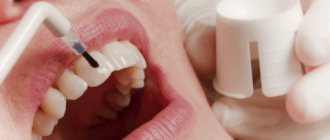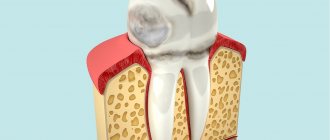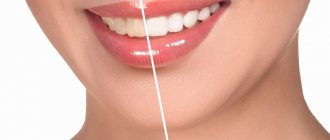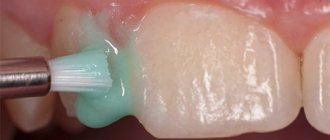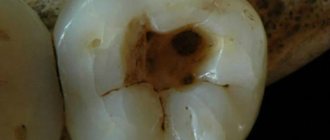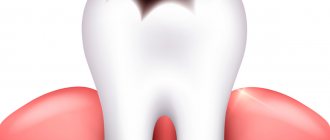Tooth enamel is one of the strongest tissues in the human body. However, the margin of safety given to us by nature is not always sufficient. Enamel is destroyed under the influence of external factors (cold and hot foods, whitening procedures), as well as from a lack of fluoride, calcium and phosphorus. One of the ways to restore it is to coat the teeth with fluoride varnish. Below we will tell you in what cases and how this procedure is carried out and what its effect on tooth enamel is.
Prices
| Deep fluoridation (one tooth) | 250 rub. |
Fluoridation: strengthening and protecting teeth
Since childhood, we have all been told that we need to eat less sweets and more fresh fruits, vegetables and dairy products. And why all? They contain useful vitamins and minerals that support the health of the body, give energy and strength. Our teeth also need additional nutrition. When teeth are strong from the inside, they are better able to withstand external influences, which means that the risk of caries is reduced significantly. How to strengthen and restore tooth enamel? What is fluoridation and why is fluoride varnish needed?
Contraindications
Parents should not insist on the procedure if caries or problems with enamel appear, since there are a number of contraindications that must be taken into account before fluoridation.
- Fluoridation cannot be carried out if children are diagnosed with fluorosis.
- If there is an increased level of fluoride in the drinking water where you live.
- If there is deep caries on the teeth.
- For inflammatory processes on the gums.
- If you have allergic reactions to substances.
What is dental fluoridation?
This is a procedure for strengthening enamel, during which a specialist applies a preparation containing useful microelements to the teeth, the main of which are fluoride and calcium.
The special composition penetrates deep into the enamel, fills the pores, thereby restoring and strengthening its structure. A protective barrier against bacteria is formed on the teeth. Why is it important to have fluoridation done by a dentist? The fact is that the procedure is especially effective when the enamel is clean and polished. Often, strengthening teeth is the final stage of professional oral hygiene. The specialist first carries out ultrasonic and abrasive cleaning of stone and plaque, and then saturates the enamel with minerals. This way it better absorbs all the useful components.
What it is
The structure of tooth enamel is a crystalline network consisting of tiny prisms of hydroxyapatite. The porous structure of this mesh allows acids to penetrate the enamel layer and remove minerals that are so important for the health of the enamel. Such an aggressive effect leads to demineralization of dental tissues and the onset of a carious process, which gradually destroys all layers of the tooth from enamel to pulp.
And this is where remineralization of tooth enamel comes to the rescue, which helps restore mineral content and prevent the development of caries.
Remineralization is a restorative process that helps replenish missing minerals in tooth enamel, starting with a decrease in acidity in the oral cavity.
In a normal, healthy body, remineralization of teeth occurs constantly, along with demineralization. Both processes are completely natural, demineralization occurs when eating food, especially with a high content of acids and sugar, and saliva plays the main role in replenishing the mineral content of enamel. It reduces the level of acidity and, due to its composition, replaces previously destroyed minerals.
If the body is not completely healthy, the acid-base balance is disturbed and saliva ceases to fulfill its natural role as a reducer. Minerals are destroyed, a fertile environment for pathogenic bacteria is formed, and caries begins to develop rapidly. In this case, at the initial stage of development of the carious process, artificial remineralization of tooth enamel can help. This procedure not only restores the structure of the enamel layer, preventing further development of caries, but also reduces the increased sensitivity of the tooth to external irritants.
Consultation with a dentist: The tooth feels cold and hot
Remineralization is carried out not only to eliminate existing carious destruction, but also for prevention, so it can be prescribed even to children from the age of six. Remineralizing gel, varnish or enamel contains fluorine, calcium, phosphorus and other useful minerals. Of course, only a dentist can carry out this procedure correctly and without errors.
Fluoridation of teeth for children: benefit or harm?
The child’s baby teeth are not yet strong: they have fragile enamel, followed by a thin dentin layer, and at the base there is a soft pulp chamber with nerve endings and blood vessels. Therefore, children's teeth are more easily damaged; caries often forms on them, which can quickly develop into complications. It seems like just yesterday there was a small dark spot on the enamel, and today your child is complaining of severe toothache and refuses to eat.
To reduce the risk of tooth decay, baby teeth need to be cleaned regularly and properly, and strengthened. How can you help your children maintain a beautiful smile and protect them from toothache? With the appearance of the first teeth, bring your child to the dentist for a preventive examination 2-3 times a year. The pediatric dentist will promptly identify possible problems, teach in a playful manner the correct technique for brushing teeth, and also carry out fluoridation that is beneficial for the enamel.
Silvering of teeth: advantages and disadvantages of the procedure
Coating children's teeth with silver is one of the most gentle technologies for treating childhood caries in the initial stages. This method is not new in dentistry; it has been used for many decades. The noble metal itself is not used in treatment, but only its active salts. The tooth surface treated in this way becomes denser and more resistant to food acids.
Silvering of teeth is effective only in the initial stage of the carious process, when it appears on the enamel as small spots. The technique is indicated for children under three years of age.
The positive aspects of the procedure include:
- an excellent way to stop the progression of caries on a child’s teeth;
- silvering does not cause negative reactions on the part of a young patient;
- The cost of the procedure is low, which makes it accessible to all patients.
The disadvantages of coating children's teeth with silver include:
- the formation of black plaque on the tooth surface, which does not create an aesthetic effect;
- For deep carious lesions, the technique cannot be used.
Dentists do not recommend silvering the front teeth, because the resulting black plaque causes psychological discomfort in the child. Along with this, there are other contraindications: allergies to the components of the drug, the patient has somatic diseases, in cases of dentin damage by caries and the child is over 3 years old.
Among the most popular drugs for the silvering procedure are domestically produced Argenate and Japanese Saforide. Both products have a therapeutic and prophylactic effect on tooth enamel and are completely harmless to the child’s health.
Simple fluoridation of teeth
The most common way to strengthen teeth. It is used to prevent caries. A special composition is applied to the enamel, which forms a thin protective film. What kind of composition is this? Fluoride varnish, fluorine-containing varnish, fluoride varnish or simply enamel restoration varnish - the strengthening agent has several names, but the result is the same. Your teeth are reliably protected, and the effect lasts up to six months.
Algorithm for the procedure
Simple
If the baby is prescribed simple fluoridation, the procedure is as follows:
- Plaque and deposits are removed from the teeth.
- Taking into account the structure of the child’s incisors, special casts are made.
- They are coated with a composition that, upon contact with the enamel, begins to release ions. This treatment takes about 15 minutes.
- Then the manipulations are repeated again. Thanks to this, calcium fluoride crystals saturate the hard tissue of the tooth, due to which the enamel is strengthened and the destruction of the incisors from caries is stopped.
- The procedure is repeated 10 to 15 times.
Glubokoe
The procedure is divided into several stages. Despite the fact that the algorithm of actions is quite simple, it is very important to carry it out correctly in order to obtain the necessary positive effect.
- The dentist removes plaque and stone.
- The gaps are being cleaned.
- For this purpose, special nozzles and brushes are used.
- Next, the surface is dried using warm air to create a strong adhesion between the enamel and the substance.
IMPORTANT: It is very important to achieve maximum cleanliness.
- The surface of the teeth is treated with a solution of calcium fluoride, which contains fluoride ions.
- Treat with warm air again.
- Next, the cotton swab is soaked in a solution consisting of calcium and copper hydroxide.
- Apply the composition on all sides.
If parents decide to carry out this healing technique, you can find on the Internet how fluoridation of children’s teeth has a positive effect, photo. The incisors become snow-white and healthy.
Deep fluoridation of teeth
This is a more effective way to strengthen enamel.
For deep fluoridation, a more saturated fluorogel is used. It acts not only on the surface of the teeth, but also penetrates into the deep layers of enamel. Useful microelements, as a building material, restore the structure of the tooth, preventing the development of initial caries. The strengthening effect lasts up to a year. Fluoridation of teeth has a positive effect in most cases.
But before carrying out the procedure, you must consult a specialist. Oversaturation of enamel with fluoride, as well as its lack, are equally harmful to health. Do you want your teeth to be strong? Take care of them. Take just one day out of your busy schedule and visit the dentist. Fluoridation will strengthen the enamel for a long time and protect teeth from caries.
Commenting system SigComments
Back to section
Indications for use
Many citizens are sure that the most important microelement for teeth is calcium. This is partly true: calcium is responsible for the structural strength of bones. However, fluorine is important for enamel; it is what ensures the strength of its structure. Fluoride is absorbed not only with water and food; this microelement is well absorbed by the enamel from the outside. Therefore, scientists created the drug Fluorlak. Let's consider the question: Fluoride varnish instructions for use.
Enamel protection with a fluoride-containing agent is carried out in dental clinics. However, you can coat your teeth with fluoride varnish yourself. A home procedure will be much cheaper and will save time. Who is the fluoridation procedure indicated for? A lack of fluoride in drinking water provokes massive caries disease, so fluoridation is primarily indicated for people living in the area. The use of the drug is also indicated:
- people with high enamel permeability;
- pregnant and elderly people;
- children over six years of age living in areas with low fluoride content in water;
- with mechanical destruction of enamel: chips, cracks;
- before placing dentures (after grinding the crown);
- after ultrasonic cleansing;
- with a wedge-shaped defect.
A contraindication to fluoridation is an excess of fluoride in bone tissue (fluorosis) and sensitivity to the components of the drug.
Fluoridation in the doctor's office
How does the fluoride varnish treatment process work? The dentist uses a special brush or roller for this. Before the procedure begins, the crowns of the teeth are treated: plaque is removed, and any hard formations are removed. Then salivation is eliminated and the surface of the teeth is dried.
The coating begins with the lower jaw, after which it moves to the upper dentition. When the treatment is completed, the patient remains with his mouth open for some time until the composition dries completely. After fluoridation, you should not brush your teeth or eat hard foods for a day, so as not to damage the fresh layer of varnish. Since it is impossible to apply a thick layer of fluoride in one procedure, fluoridation is carried out several times at intervals of 3-4 days.
How long will fluoride varnish last in dentistry? Typically, the protective film lasts for six months, so after this period of time the procedure should be repeated. Does this product change the color of the enamel? No, a similar effect was not noticed after using Fluoride Lac.
Fluoride varnish for teeth at home
How to apply fluoride varnish for teeth at home? Coating teeth with the composition is not difficult, however, buying the drug is quite problematic: it cannot be found in pharmacies. To purchase this product (Fluorolak Omega), you must place an order in stores specializing in the sale of dental products.
How to apply fluoride varnish instructions:
- Clean your mouth with paste.
- Dry the surface of the teeth: to do this, wipe the crowns with a cotton swab or place gauze pads between the lips/cheek and isolate the teeth from saliva.
- Soak a cotton swab in the solution and rub the enamel (it is better to start treating the crowns of the bottom row).
- Keep your mouth open until the mixture dries (takes about five minutes).
Important! After treating enamel with fluorine-containing varnish, you should not eat for 12 hours, so it is advisable to carry out the procedure in the evening. The sooner the food touches the coating, the less time it will last.
What difficulties may arise during the home fluoridation procedure? Do not allow the composition to come into contact with the mucous membrane. It is necessary to carefully monitor the application of fluoride varnish to the teeth. If the product gets on the mucous membrane, it can cause negative consequences - a burn.
